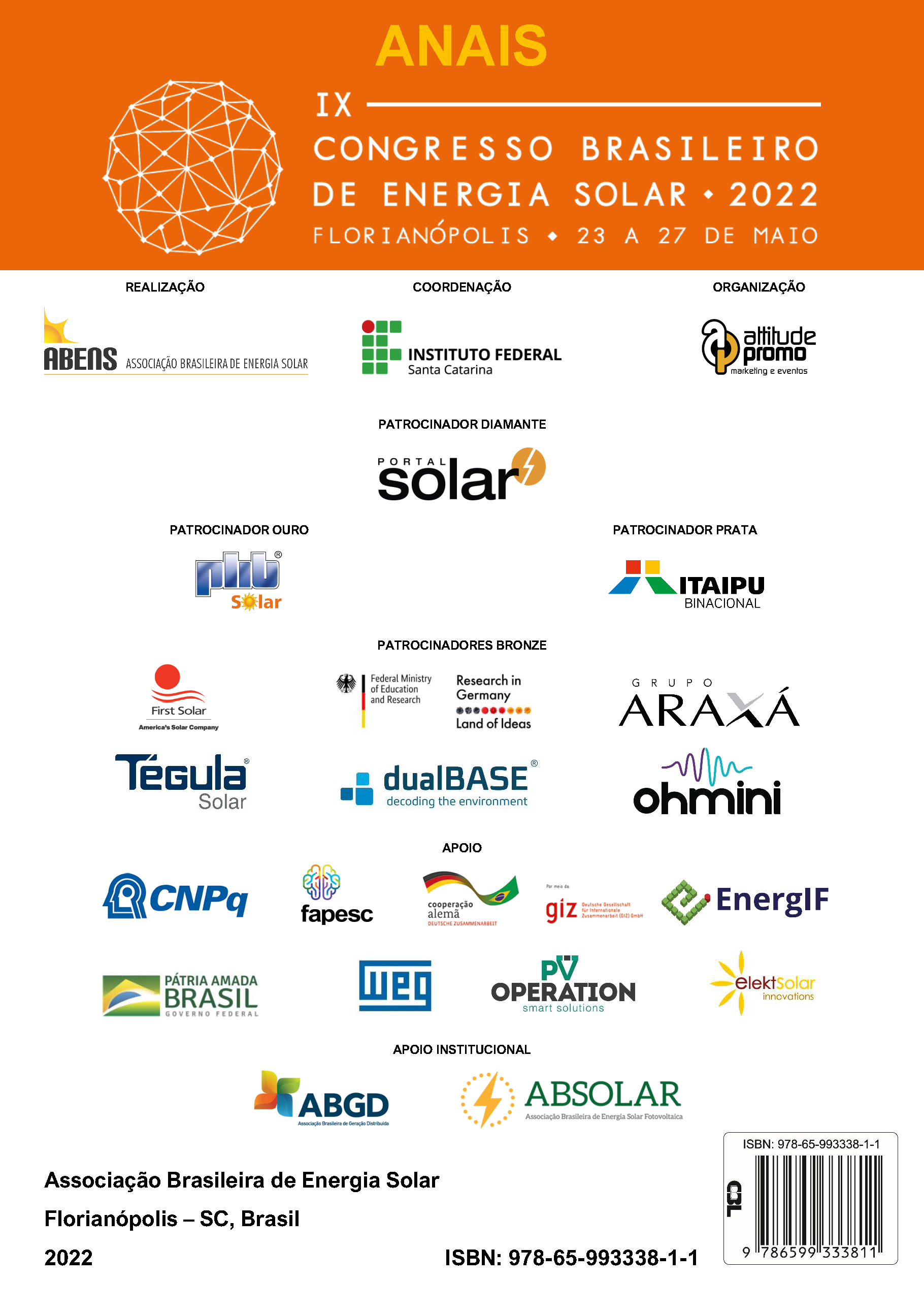INFLUENCE OF THE INVERTER SIZING FACTOR ON THE PERFORMANCE OF PHOTOVOLTAIC SYSTEMS CONNECTED TO THE GRID IN OPERATION IN SOUTH OF BRAZIL
DOI:
https://doi.org/10.59627/cbens.2022.1118Keywords:
Photovoltaic Solar Energy, Merit Indices, Inverter Sizing FactorAbstract
In recent years, distributed generation with photovoltaic systems has shown exponential growth based on technical, economic and regulatory aspects. The performance of a photovoltaic system depends, in particular, on environmental factors, solar radiation and ambient temperature, and on the electrical characteristics of components, modules and inverters. The inverter sizing factor (FDI) is defined as the ratio between the inverter's AC power and the PV generator's rated power. The inverter's conversion efficiency is a function of the relative power, that is, the inverter charging level and the dc voltage input. Monitoring and analyzing photovoltaic systems is important to verify the technology's performance and reliability. Merit indices are related to system efficiency, productivity, system losses and the electrical energy produced. This article presents a study of the productivity (YF), performance rate (PR) and inverter conversion efficiency indices of two subsystems (Sub 1 and Sub 2) of a grid-connected photovoltaic system (SFCR) installed at the Federal Institute of Santa Catarina (IFSC) in Criciúma/SC. The analysis horizon is between 2018 and 2020. The modules of Sub 1 and Sub 2 subsystems present the same inclination and azimuth angles. The Sub 1 subsystem has an FDI of 1.12 while the Sub 2 subsystem has an FDI of 0.76. The annual productivity of Sub 1 ranged between 1221 kWh/kWp and 1295 kWh/kWp while the annual productivity of Sub 2 ranged between 1223 kWh/kWp and 1277 kWh/kWp. The monthly average conversion efficiency values of the Sub 1 inverter are similar to the monthly average conversion efficiency values of the Sub 2 inverter over the entire analysis horizon.
Downloads
References
Deschamps, E. M.; Rüther, R., 2019. Optimization of inverter loading ratio for grid connected photovoltaic systems, Solar Energy, vol. 179, pp. 106-118.
International Electrotechnical Commission (IEC 61724-1). Photovoltaic system performance – Part 1: Monitoring. 2017.
Marion, B.; Adelstein, J.; Boyle, K.; Hayden, H.; Hammond, B.; Fletcher, T.; Canada, B.; Narang, D.; Shugar, D.; Wenger, H.; Kimber, A.; Mitchell, L.; Rich, G.; Townsend, T., 2005. Performance parameters for grid-connected
PV systems. In: 31st IEEE Photovoltaics Specialists Conference and Exhibition, pp. 1601–1606. NREL/CP-520- 37358, Lake Buena Vista, Florida.
Pereira, E. B.; Martins, F. R.; Gonçalves, A. R.; Costa, R. S.; Lima, F. J. L.; Rüther, R.; Abreu, S. L.; Tiepolo, G. M.; Pereira, S. V.; Souza, J. G. 2017. Atlas brasileiro de Energia Solar, 2ª edição, pp. 88. São José dos Campos.
Rampinelli, G. A., Krenzinger, A., Prieb, C. W. M., 2007. Influência do fator de dimensionamento do inversor na correlação entre energia elétrica e irradiância solar em uma usina fotovoltaica conectada à rede. In: 22 Eur. Photovolt. Sol. Energy Conference.
Rüther, R. 2004. Edifícios Solares Fotovoltaicos. O Potencial da Geração Solar Fotovoltaica Integrada a Edificações Urbanas e Interligada à Rede Elétrica Pública no Brasil, 1ª edição, pp. 113. Florianópolis.
Scarabelot, L., 2020. Influência do fator de dimensionamento de inversor no desempenho termoenergético de sistemas fotovoltaicos de geração distribuída, Tese de Doutorado, UFSC, Florianópolis.
Zomer, C.; Custódio, I.; Goulart, S.; Mantelli, S.; Martins, G.; Campos, R.; Pinto, G.; Rüther, R., 2020. Energy balance and performance assessment of PV systems installed at a positive-energy building (PEB) solar energy research centre, Solar Energy, vol. 212, pp. 258-274.


